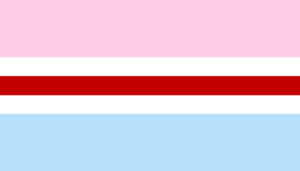Hijra: Difference between revisions
imported>TXJ No edit summary |
(included Indonesia as part of an Asian culture) |
||
| Line 2: | Line 2: | ||
[[File:Hermaphrodite Indian entertainers (c. 1865).jpg|thumb|A group of Hijra, circa 1865.]] | [[File:Hermaphrodite Indian entertainers (c. 1865).jpg|thumb|A group of Hijra, circa 1865.]] | ||
[[File:Hijra Protest Islamabad.jpg|thumb|A Pakistani hijra at a protest between two hijra groups from Islamabad and Rawalpindi. 2008.]] | [[File:Hijra Protest Islamabad.jpg|thumb|A Pakistani hijra at a protest between two hijra groups from Islamabad and Rawalpindi. 2008.]] | ||
In south Asian countries including India, Pakistan, and Bangladesh, the [[Hijra]] are people who were [[AMAB|assigned male at birth]] and who have a [[femininity|feminine]] [[gender expression]]. This is a very ancient tradition of a [[nonbinary]] [[gender role]] (often called "[[third gender]]"). The Hijra in India alone may number as many as 2,000,000.<ref>Reddy, Gayatri, With Respect to Sex: Negotiating Hijra Identity in South India, 310 pp., University of Chicago Press, 2005 ISBN 0-226-70755-5 (see p. 8)</ref> | In south Asian countries including India, Indonesia, Pakistan, and Bangladesh, the [[Hijra]] are people who were [[AMAB|assigned male at birth]] and who have a [[femininity|feminine]] [[gender expression]]. This is a very ancient tradition of a [[nonbinary]] [[gender role]] (often called "[[third gender]]"). The Hijra in India alone may number as many as 2,000,000.<ref>Reddy, Gayatri, With Respect to Sex: Negotiating Hijra Identity in South India, 310 pp., University of Chicago Press, 2005 ISBN 0-226-70755-5 (see p. 8)</ref> | ||
==Legal Recognition== | ==Legal Recognition== | ||
Revision as of 16:09, 21 January 2021
In south Asian countries including India, Indonesia, Pakistan, and Bangladesh, the Hijra are people who were assigned male at birth and who have a feminine gender expression. This is a very ancient tradition of a nonbinary gender role (often called "third gender"). The Hijra in India alone may number as many as 2,000,000.[1]
Legal Recognition
In some countries today, Hijra are legally recognized as a gender other than female or male.
- India, November 2009[2] Owing to the Hijra, India allows passports to use the gender marker "T", meaning transgender or third gender,[3] as well as "E" (eunuch).[4] However, this distinction doesn't grant them all civil rights (for example, in order to vote, one needs to identify as either male or female).
- Pakistan, December 2009 [5]
- Bangladesh, November 2013 [6] In 2011, Bangladesh started to allow passports to show a gender called "other", owing to the Hijra.[7][4]
Notable hijras
Please expand this section.
In fiction
- River of the Gods and Cyberabad Days by Ian McDonald. A novel set in futuristic India in year 2050, with interesting subplots about hijra.
Flags
The first known hijra flag was created in 2016 by a user under the handle "HijrAnon".[8] HijrAnon wrote of the flag's symbolism:
| « | The flag I have made here is based on Ardhanarishvara. A deity that is a combination of Lord Shiva and his consort Parvati, thus Ardhanarishvara is literally half-man, and half-woman. Many hijra such as myself identify with Ardhanarishvara because of the gender ambiguty, since they are neither of the two big genders. The pinkish background is also meant to be ambigous, looking like a pink or dark red depending on how you look at it (not sure if this makes sense, sorry!). The head shape with one half white and one half greenish is meant to represent Ardhanarishvara (the white half is Lord Shiva, green half is Parvati, light green middle is Ardhanarishvara themselves). The yellow ring near their neck is meant to be a necklace, in India necklaces are usually worn for protection and good luck. So in a way I wanted this to represent protection for hijras. | » |
Another hijra flag was created in 2018 by a hijra on Tumblr named Samira, who wrote:
| « | pink and blue are for those of us who identify with binary genders as trans people, while the white is for those of us who are nonbinary
the red represents the divinity we were blessed with by Rama |
» |
However, as of 2020, Samira no longer identifies as hijra.[9]
See also
- Gender-variant identities worldwide
- Gallae
- Eunuch
- Two-Spirit
- Glossary of Hindi gender and sex terminology
- Recognition
References
- ↑ Reddy, Gayatri, With Respect to Sex: Negotiating Hijra Identity in South India, 310 pp., University of Chicago Press, 2005 ISBN 0-226-70755-5 (see p. 8)
- ↑ Harmeet Shah Singh (12 November 2009). "India's third gender gets own identity in voter rolls". CNN. Retrieved 4 December 2020.
- ↑ Kellaway, Mitch (9 May 2015). "Trans Indian's Predicament at Border Shows the U.S. Lags Behind". The Advocate. Retrieved 4 December 2020.
- ↑ 4.0 4.1 Hopper, Tristin (9 May 2012). "Genderless passports 'under review' in Canada". National Post. Retrieved 4 December 2020.
- ↑ Misra, Ria (25 December 2009). "Pakistan Recognizes Third Gender". Politics Daily. Archived from the original on 27 February 2010.
- ↑ Karim, Mohosinul (11 November 2013). "Hijras now a separate gender". Dhaka Tribune. Archived from the original on 11 November 2013.
- ↑ Macarow, Aron (9 February 2015). "These Eleven Countries are Way Ahead of the US on Trans Issues". ATTN:. Retrieved 1 October 2020.CS1 maint: extra punctuation (link)
- ↑ HijrAnon (17 December 2016). "So next set of information, for culture genders, is hijra!".
- ↑ Samira (4 August 2020). "this post is blowing up again, but I want people to know that I no longer identify as hijra". Archived from the original on 4 December 2020.




